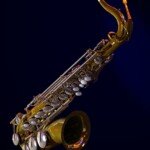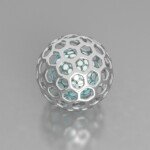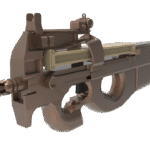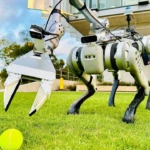Unlocking Dynamic Design: The Magic of Metal 3D Printing Articulated Snake Printing
Imagine a metal part that moves with the serpentine grace of a living snake—bending, twisting, and articulating naturally without the need for complicated assembly. This isn’t science fiction; This is a fascinating reality Articulated snake printa design paradigm perfectly suited to its unique function Direct Metal Laser Sintering (DMLS) and SLM (Selective Laser Melting) Technology.
For designers, engineers and innovators who push boundaries, the Articulated Serpentine represents a leap forward. These designs go beyond static parts, printing interlocking rings or segments as a unified part. The magic lies in the precise clearances and geometries achievable only Fusion 3D printing with high-resolution powder beds.
Why an articulated snake needs metal 3D printing
- Unparalleled geometric freedom: Traditional manufacturing methods such as CNC machining or injection molding simply cannot create the complex internal voids and interconnected geometries required for an articulated snake. They struggle (or fail entirely) with undercutting and the precise micro-clearance required for smooth articulation.
- Single piece manufacturing: The real power lies in monolithic printing. Eliminating the need for multiple parts, fasteners or post-print assembly greatly reduces complex logistics, potential failure points, assembly time and overall weight. Snakes are born with a function.
- Micron level accuracy: Achieving reliable, smooth articulation requires precise control of tolerances. The metal 3D printing system used by GreatLight resolves features down to the micron level and maintains meticulous gap consistency between parts – critical for friction management and movement.
- Material properties: Metals machined by DMLS/SLM, such as titanium, stainless steel, aluminum, Inconel or cobalt-chromium, provide the ideal combination of strength, durability, biocompatibility (for medical purposes) and wear resistance required for functional joint components to withstand motion and load.
Design Principles for Successful Snake Printing
Creating a reliable articulated snake requires more than just drawing squiggly lines. Here are the highlights from GreatLight experts:
- Critical gap design: This is the most important thing! The gap between segments must be:
- Large enough to prevent sticking/fusion during printing and allow free movement.
- Small enough to maintain structural integrity, prevent excessive movement, and keep debris out.
- The entire structure remains consistent. To achieve this, we take into account material-specific shrinkage and thermal effects during the printing process. GreatLight’s high-resolution equipment ensures exceptional accuracy.
- Ring geometry: The shape of the interlocking rings significantly affects strength and movement.
- Spherical rings generally provide the greatest range of omnidirectional motion, but may be weaker under tension.
- Cylindrical or hinged designs provide controlled one- or two-way bending and potentially higher tensile strength.
- Faceting or adding key features can affect stiffness and locking points.
- Support structural strategies: Supporting overhang sections is necessary, but designing easily removable supports near hinge gaps is critical to avoid damaging delicate features of the post-processing. This is an area where our extensive finishing expertise is crucial.
- Material selection: In addition to strength, consider:
- wear: Will the parts rub against each other repeatedly? Harder materials (such as CoCr) or surface treatments (such as polishing, DLC coating, available from GreatLight) may be required.
- corrosion: For harsh environments (marine, chemical) stainless steel or nickel alloys are preferred.
- Biocompatibility: For medical tools or implants, certified Ti64 (Grade 5 or 23) or specific CoCr alloys are essential.
Where articulated snakes slide into reality
The applications of these dynamic metal structures are rapidly expanding:
- Medical and surgical instruments: Articulated laparoscopic tools, endoscopic camera sleeves, steerable catheters, minimally invasive biopsy devices. One-piece construction improves sterility and reliability.
- Robotics and Automation: Flexible end effectors, flexible clamps, snake-like robotic arms for limited spaces, adaptable connectors.
- Integrate and maintain fixtures: Articulating cable guides in machinery, flexible maintenance tools for hard-to-reach areas, adaptable clamps and fixtures to accommodate complex shapes.
- Innovative consumer products: High-end articulated jewelry, customizable tech accessories, unique sculptural pieces.
- Aerospace and Defense: Imminent manipulators for narrow cabins, deformable structures, adaptable payload interfaces.
GreatLight: Your co-innovation partner
Taking the articulated snake concept from CAD to reality required more than just a printer. It requires expertise across the entire additive manufacturing lifecycle. This is the advantage of GreatLight:
- Advanced technology: Our state-of-the-art DMLS/SLM metal printers deliver micron-level accuracy and reliability, which is critical for complex gap geometries and consistent segment quality.
- Material mastery: We offer a full range of high-performance metal powders, including biocompatible options, and provide advice on the best material selection to suit your application’s functional requirements.
- Engineering expertise: Our team has deep design knowledge for Additive Manufacturing (DfAM). We work with you to optimize your snake design for printability, strength and articulation reliability – providing advice on clearance, orientation, supports and topology.
- Complete additive manufacturing lifecycle support: Honglaite provides a true one-stop solution. In addition to professional printing, we also specialize in professional post-processing: meticulous support removal, advanced heat treatments (such as HIP), precision machining of critical surfaces, and a suite of finishing services (polishing, electropolishing, sandblasting, coating) to ensure the final snake runs smoothly and meets aesthetic requirements.
- Speed and customization: Need rapid prototyping or low-volume production? Our process is designed for efficient turnaround without compromising the precision required for your articulation design. Custom material requirements? We can customize solutions.
in conclusion
The articulated snake print demonstrates the transformative power of metal 3D printing. It frees designers from the constraints of traditional manufacturing, enabling strong, flexible, minimally assembled metal parts that were previously impossible or prohibitively expensive. By mastering the intricacies of gap design, materials science, and precision printing, amazing functional freedom is achieved.
For innovators looking to incorporate fluid motion and complex articulation into metal parts, working with a highly skilled manufacturer like GreatLight is critical. Leverage our state-of-the-art equipment, deep DfAM knowledge and comprehensive post-processing capabilities to ensure your articulated snake design not only works, but performs reliably and exceeds expectations. Unleashing the dynamic potential of metal additive manufacturing.
FAQ: Articulating Snake Printing Using Metal 3D Printing
Q1: What are the commonly used metal materials for articulated snakes?
A1: The choice depends on application requirements. Popular choices include titanium alloys (Ti6Al4V – excellent strength-to-weight ratio, biocompatibility), stainless steels (e.g., 316L – corrosion-resistant), aluminum alloys (AlSi10Mg – lightweight, strong), cobalt-chromium alloys (CoCr – extremely hard, wear-resistant, biocompatible), and nickel alloys (e.g., Inconel – heat-resistant). GreatLight provides these and can advise on the best materials.
Q2: How small can the gap between segments be reliably printed?
A2: This highly depends on the resolution and operating parameters of the specific metal printer. With advanced DMLS/SLM systems like GreatLight, clearances are reliably reduced to 100-200 microns (0.1 – 0.2 mm) is achievable, sometimes even more elaborate, depending on geometry and materials. accomplish continuous The gaps are critical and require expert process control.
Question 3: Will the printed snake segments fuse together during the build process?
A3: This is the primary problem to be solved through careful design and process control. Carefully calculated gap sizes act as insulators, preventing the laser from fusing adjacent segments together. Expert guidance and support strategies, coupled with the precise laser control employed by GreatLight technicians, virtually eliminates this risk.
Q4: How strong is the hinged serpentine joint compared to traditional hinges?
A4: While a single serpentine joint may be strong, especially under compression, conventional machined hinges are generally good at handling very high axial or tensile loads with bearing pins and strong knuckles. The highlight of the serpentine joint is that it provides complex multi-directional flexibility in a tightly packed, lightweight monolithic design. They are strong enough for their intended applications (medical devices, flexible catheters, specialized robots).
Q5: How to remove internal support structures without damaging fragile joints?
A5: This requires expertise – a key part of GreatLight’s post-processing services. Technologies include:
- Remove carefully by hand using precision tools.
- Strategic design of supports using weaker interfaces such as tiny touch points.
- If critical interface surfaces require finishing, advanced processes such as CNC machining are used.
- Electropolishing smoothes the surface and may help remove debris.
Q6: What are the restrictions on the overall size of the snake?
A6: The size is mainly limited by the build volume of the metal 3D printer. Using a system with different chamber sizes, GreatLight is able to print snakes ranging from a few centimeters in length to potentially over 30-40 centimeters in length. Larger snakes require careful consideration of thermal management during the printing process to prevent warping. Segment size and wall thickness also affect scalability.
Q7: Is it cost-effective to produce rather than just prototype?
A7: Yes, especially for low to medium volume production, complex designs, or applications that require the unique advantages of integral articulation. The cost per part is typically justified by the following factors:
- Eliminate assembly costs.
- Reduce parts count (simplify inventory/quality control).
- Performance advantages (weight, reliability, functionality).
- Design iteration speed.
GreatLight focuses on maximizing the efficiency of the entire process to achieve cost-effectiveness. Please contact us for a specific project evaluation.
Q8: If I have a concept but no detailed CAD, can GreatLight help me design the articulated snake part?
A8: Of course! Our engineering team specializes in Design for Additive Manufacturing (DfAM). We work closely with our customers to understand the functional requirements of the joint (range of motion, loading, environment) and translate concepts into optimized printable designs, leveraging our deep expertise in serpentine geometry, gap design, and material behavior.
Ready to bring your most complex, dynamic metal concepts to life? Contact GreatLight today for a consultation about your articulated snake project or any demanding metal 3D printing challenge. Customize your precision parts today with expert solutions at competitive prices.










































